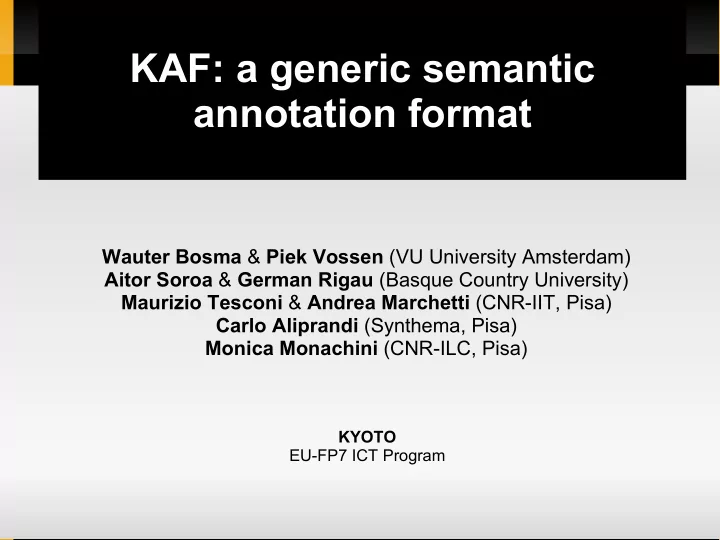

KAF: a generic semantic annotation format Wauter Bosma & Piek Vossen (VU University Amsterdam) Aitor Soroa & German Rigau (Basque Country University) Maurizio Tesconi & Andrea Marchetti (CNR-IIT, Pisa) Carlo Aliprandi (Synthema, Pisa) Monica Monachini (CNR-ILC, Pisa) KYOTO EU-FP7 ICT Program
KYOTO – overview A system for defining and sharing meaning in a domain Domain wordnet (linked to generic wordnet) Ontology (linked to wordnet) Fact profiles Semantic interoperability Knowledge is maintained by end-users System can be used for extracting factual data from documents Cross-language; cross-culture
KYOTO – some statistics March 2008 – March 2011 8 countries (The Netherlands, Italy, Germany, Spain, Taiwan, Japan, Czech Republic) 12 sites Universities & research institutes: VUA, CNR-ILC, CNR-IIT, BBAW, EHU, AS, NICT, Masaryk Companies: Synthema, Irion User organizations: ECNC, WWF 7 languages (English, Italian, Japanese, Dutch, Spanish, Basque, Chinese)
KYOTO – knowledge cycle
Linguistic Linguistic Wordnets & Ontology Wordnets & Ontology Processor Processor Multilingual Multilingual Knowledge Base Knowledge Base Semantic & Syntactic Semantic & Syntactic Wikyoto Wikyoto Kybot Kybot Kybot representation representation Kyoto Annotation Format Kyoto Annotation Format Wiki Editor Wiki Editor Fact Extractor Fact Extractor Fact Extractor 2 2 1 1 Tybot Tybot Tybot Term Base Term Base Term Extractor Term Extractor Term Extractor Fact Base Fact Base
Requirements for semantic annotation in KYOTO Interoperability across languages and cultures Language-neutral annotation One format for all languages Interoperability across linguistic processors Specialized processors for specific tasks System should work with new (unknown) languages Flexibility and extendibility , as requirements for applications may change over time
The KYOTO way KAF: KYOTO/Knowledge Annotation Format Annotation consists of layers stacked on top of each other Layers are used to generate more sophisticated layers Morpho-syntactic layers – Level-2 semantic layers language specific parsing Level-1 semantic layers Level-1 semantic layers – named entities, events, etc. Morpho-syntactic layers Level-2 semantic layers – facts Layers refer to items in lower level layers KAF is LAF-compliant
Morpho-syntactic layers Text: tokenization, sentences, paragraphs, with reference to the Level-2 semantic layers source Terms [Text]: words and multi- Level-1 semantic layers words, includes parts-of-speech, declension information, etc. Chunks Dependencies [Terms]: Dependencies dependency relations between terms Terms Chunks [Terms]: constituents & Text phrases
Semantic layers Level-1 layers for linear annotation : tagging text elements (expressions of time, events, quantities, locations, etc.) Level-2 layers for generic annotation : extracted facts (with pointers to evidence in the text) – possibly multiple sources of evidence Linear vs. Generic ↔ Information vs. Knowledge
General KAF layout <kaf xml:lang="en"> <kafHeader>...</kafHeader> layer 1... layer 2... ... layer N... </kaf>
Morpho-syntactic annotation: text and terms <kaf> <text> <wf wid=”w1” page=”1” sent=”1” para=”1” fileoffset=”0,3”> tw o </wf> <wf wid=”w2” page=”1” sent=”1” para=”1” fileoffset=”4,7”> pe r </wf> <wf wid=”w3” page=”1” sent=”1” para=”1” fileoffset=”8,12”> c e nt </wf> </text> <terms> <term tid=”t1” type=”open” lemma=”two” pos=”G”> <span id=”w1”/><!-- refers to ”two” (w1) --> </term> <term tid=”t2” type=”open” lemma=”per cent” pos=”N”> <span id=”w2”/><span id=”w3”/> </term>
Morpho-syntactic annotation: deps and chunks <kaf> <text>...</text><!-- defines w1, w2, w3 --> <terms>...</terms><!-- defines t1, t2 --> <deps> <!-- dependency: ”two” (t1) → ”per cent” (t2) --> <dep from=”t1” to=”t2” rfunc=”mod”/> </deps> <chunks> <!-- two per cent --> <chunk cid=”c1” head=”t2” phrase=”NP”> <span id=”t1”/><!-- refers to term: ”two” --> <span id=”t2”/><!-- refers to term: ”per cent” --> </chunk> </chunks>
Linear semantic annotation <timexs> <!-- 1970 --> <timex3 texid="timex1" type="DATE" value="1970"> <span><target id="c7"/></span> </timex3> <!-- 2003 --> <timex3 texid="timex2" type="DATE" value="2003"> <span><target id="c9"/></span> </timex3> <!-- between 1970 and 2003 --> <timex3 texid="timex3" type="DURATION" value="P33Y" beginPoint="timex1" endPoint="timex2" temporalFunction="true"/>
Generic annotation <entities> <ent eid =”e1”> <!-- change --> <spans> <span><target doc=”134” id="c7"/></span> <span><target doc=”134” id="c34"/></span> <span><target doc=”14” id="c13"/></span> </spans> <ent eid =”e300”> <!-- change --> <spans> <span><target doc=”134” id="c13"/></span> <span><target doc=”4” id="c3"/></span> </spans> </entities>
Generic annotation <facts> <!-- Source: between 1970 and 2003, tropical Species [...] Temperate species populations have shown little overall change. --> <!-- Fact: change(temperate species populations, little, 1970–2003) --> facts facts <fact fid="f1"> entities entities <!-- change --> semantic roles semantic roles <process eid="e1"/> dependencies dependencies <!-- little --> chunks chunks <quantity qid="q1"/> term: migration term: migration <!-- between 1970 and 2003 --> Wordnet synset {eng-30-6766767-v} Wordnet synset {eng-30-6766767-v} <timex3 texid="timex3"/> Ontology Type = MigrationProcess Ontology Type = MigrationProcess - MigratingSpecies - MigratingSpecies <!-- temperate species populations --> - Source - Source <arg tid="c1" role="patient"/> - Path - Path </fact> - Distance - Distance word: migration word: migration </facts>
KAF in KYOTO Word Sense Disambiguation adds sense annotation to the terms layer of KAF Tybots (term yielding robots) use KAF for term extraction Uses the terms layer and the chunks layer Kybots (knowledge yielding robots) use KAF for fact extraction Kybot is configured to search for specific facts by defining a kybot profile Wikyoto allows domain experts to define kybot profiles and to build a domain wordnet from Tybot terms, linked to a shared ontology All of the above are language-neutral
KAF and ISO standards KAF is inspired by: SynAF (dependency relations), MAF (morphological annotation), SemAF (time and events), LAF (generic linguistic annotation framework) SynAF , MAF and SemAF cannot be stacked LAF is a data model rather than a standard KAF is an instantiation of LAF with elements from SynAF , MAF and SemAF
Conclusion Key features of KAF: Layered annotation; extendible for new applications Distributed processing Language neutral processing Sharing & reusing resources KAF in KYOTO: Three types of annotation: morphosyntactic , linear (level-1 semantic) and generic (level-2 semantic) Used for 7 languages in several applications KAF manual: www.kyoto-project.eu (under system architecture and demos , data formats )
Recommend
More recommend